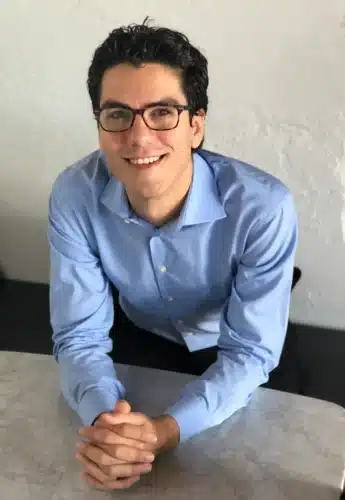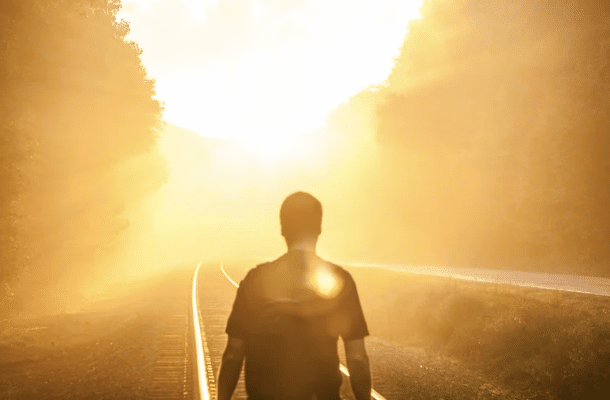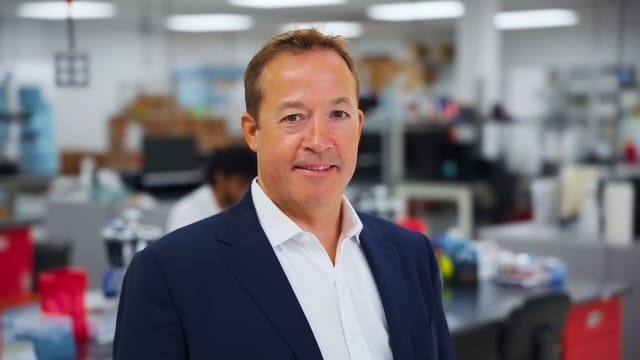The word “burnout” gets thrown around a lot. As a health coach, you’re probably used to hearing clients describe themselves as stressed, exhausted, or burned out.
But what happens when coaches start to experience burnout? When so much of our work as coaches is dependent on being present, holding space for people, and giving back to our clients, how do we make sure that we don’t become burned out in business, in coaching, and in life?
Today, we’ll hear from Dr. Diego Salinas, MD, NBC-HWC as he unpacks the hidden signs and long-term impact of burnout, shares his personal journey, and explains how he used neuroscience to shift his own behavior. He’ll also offer practical strategies for coaches to avoid burnout, build sustainable practices, and explore how platforms like Vibly can support their journey, with additional resources to help along the way.

What is Burnout?
Burnout is defined as a state of chronic physical and emotional exhaustion, often characterized by:
- Emotional Fatigue: A feeling of being emotionally drained and overwhelmed, leading to a reduced capacity for empathy and compassion.
- Cynicism: Developing a negative, cynical attitude towards work, leading to detachment from work responsibilities and clients.
- Black and White Thinking: Where everything seems either all good or all bad, with no space for nuance.
- Ineffectiveness: A diminished sense of accomplishment or productivity, leading to feelings of incompetence and dissatisfaction.
Burnout can come from prolonged exposure to stress, high workloads and client loads, decision fatigue, and a lack of balance between work and personal life. It can deeply affect both mental and physical health. You can think of burnout like an inflammatory state for the brain. It’s important to minimize the amount of time spent in that state to mitigate the most harmful effects of burnout.
The most important thing you can do to address burnout? Learn how to spot the signs early on.

How to Spot Burnout: 12 Silent Signs of Burnout
One of the most challenging things about burnout is that it has a tendency to sneak up on us. Even for coaches, who are highly self-aware, it can be challenging to recognize the signs of burnout.
Burnout is complex and unique to each individual, and the signs and symptoms vary from person to person, but there are a few common silent signs of burnout.
Take a look at this list of 12 common signs and symptoms of burnout and ask yourself – How many of these symptoms apply to me right now? What signs or symptoms do I need to start looking out for in my own behavior?
- Emotional Exhaustion: Feeling drained, overwhelmed, and unable to cope with daily tasks.
- Reduced Performance: A noticeable decline in the quality of coaching sessions or a lack of motivation to prepare.
- Cynicism or Detachment: Developing a negative attitude towards clients or the coaching profession; feeling aloof or indifferent.
- Increased Irritability: Experiencing heightened frustration and impatience, both with clients and colleagues.
- Physical Symptoms: Chronic fatigue, headaches, or gastrointestinal issues that stem from stress.
- Sleep Disturbances: Difficulty falling asleep, staying asleep, or experiencing restless nights.
- Loss of Passion: A decreased interest in coaching, once-shared passions, or enthusiasm for helping clients.
- Difficulty Concentrating: Struggling to focus during sessions, leading to disconnection from the coaching process.
- Isolation: Withdrawing from support networks, colleagues, or professional communities.
- Increased Use of Coping Mechanisms: Relying on unhealthy habits such as overeating, substance use, or excessive screen time to cope.
- Neglecting Self-Care and Boundaries: Prioritizing work over personal well-being, leading to a lack of attention to health, nutrition, and rest; Setting poor boundaries around work that results in an inability to take proper care of yourself.
- Feelings of Inadequacy: Doubting one’s skills and effectiveness as a coach, despite having a successful track record.
The Long Term Health Effects of Burnout
Developing a sense of self-awareness around your own relationship with burnout can help you recognize the signs early on and prevent you from experiencing the worst effects of burnout. But what happens when you’ve been living in the cycle of burnout without even realizing it? What do you do when you realize that you’ve gotten so good at coping with the symptoms of burnout that it just kind of becomes the way you live your life?
The long term health effects of burnout can be significant. From sleep issues to digestive problems to pain to emotional exhaustion to diminished mental capacity, the way that burnout affects each of us both physically and mentally is highly personal and can deeply affect our quality of health and life.

Here are a few things to be on the lookout for in yourself and in your clients:
- Sleep Challenges: Chronic fatigue – Persistent tiredness that doesn’t improve with rest or sleep, insomnia, or other disruptions in sleep patterns, leading to daytime drowsiness and decreased productivity.
- Mental Health Issues: Increased risk of anxiety, depression, and learned helplessness as a result of prolonged stress.
- Increased Cortisol Levels: Chronically elevated cortisol levels can lead to all kinds of health challenges, including elevated blood glucose, dysregulated immune system, high levels of inflammation, diminished cancer protection, and so much more.
- Cognitive Impairment: Difficulty concentrating, memory issues, and a decline in decision-making abilities.
- Physical Health Problems: Heightened susceptibility to illnesses, such as respiratory infections, due to weakened immune response.
- Cardiovascular Issues: Elevated blood pressure and increased heart rate, contributing to a higher risk of heart disease.
- Digestive Problems: Issues such as stomachaches, irritable bowel syndrome (IBS), or other gastrointestinal disturbances.
- Weight Fluctuations: Unintended weight gain or loss due to changes in appetite or eating habits influenced by stress.
- Chronic Pain: Including tension headaches, muscular discomfort, and flare-ups of other conditions often reflects the impact of psychological stress through the mind-body connection.
- Social Withdrawal: Isolating oneself from friends, family, and professional networks, leading to a lack of support and increased loneliness.
- Decreased Life Satisfaction: A general sense of unhappiness and dissatisfaction with life and work, leading to a diminished quality of life.
My Own Path to Burnout
As a Neuroscientist, MD, and NBC-HWC, I’m no stranger to burnout.
I first experienced burnout as a physician in a busy hospital setting where I was constantly being pulled in many different directions, caring for too many patients with too little time, and doing admin work that took hours out of my day. It was all too much, too fast.
One of the things that surprised me most about my own experience with burnout was that when I finally worked up the courage to tell my colleagues I needed to step back, everyone said, “I don’t get it. You’re one of the best doctors here and you’re great at what you do, why would you leave!?”
Caregiving professionals are exceptional at giving our all to the people around us. But when your energy is spent caring for others without setting boundaries and caring for yourself – or worse, when it’s just an expected and everyday part of the job – it can have a serious impact on your wellbeing and can even cause a confusing shift in identity. One of the most harmful parts of burnout for healthcare professionals is that burnout can often look like thriving in your role.

When I left the hospital, I remember feeling like a huge weight had been lifted off my shoulders, but it took me months if not years to uncover the impact burnout had had on my mindset. That initial freedom and feeling of control was deceiving. I realized that even when it’s situational, burnout can have long lasting effects even when you’re removed from the environment that caused it.
My own experience with burnout is one of the things that drew me to coaching. I wanted to truly be able to spend time with my patients, to help guide them through the process of change, and to apply what I had learned in my career as a neuroscientist to support people make long lasting changes in alignment with their core values. Coaching seemed like a perfect fit for my skillset and I was excited to help people address the role of stress in their lives.
But I quickly found that all the administrative tasks involved with working a full-time coaching job and running a coaching practice on the side were getting me down. I would find clients or make connections, but miss out on the follow up after all that hard work because I couldn’t keep track of it all. My systems were a mess and I knew that if I didn’t figure out a way to keep my coaching practice efficient and organized, I wouldn’t be able to make it as a coach in private practice.
Because I had experienced the signs of burnout in my career as a Physician, I was quickly able to recognize the early signs and symptoms when it came up again in my coaching career. I drew on my background in neuroscience to help me break the cycle of burning out. Here’s what helped.
The Neuroscience of Burnout – And How I Used It To Change My Own Behavior

Let’s talk about burnout from a neuroscience perspective, and how I used what I knew about the brain to change my own behavior and start moving away from burnout.
Burnout is complex and unique to each individual. The signs and symptoms vary from person to person. For me, it manifested as tiredness, exhaustion, social withdrawal, sleep disturbances and constant feeling of heaviness in my eyes. I was able to recognize that the cause of my burnout was feeling disconnected from my why, losing my sense of autonomy, and living according to someone else’s definition of success. Recognizing those early signs and symptoms is what saved me from falling too deeply into burnout in my coaching practice.
Purpose protects the brain from chronic stress. When we connect with meaning and purpose, the brain releases dopamine and oxytocin, creating emotional resilience, even when we’re under pressure. For me, this meant focusing more on my solo coaching business where I had the autonomy to do what I felt was right, and fully live in alignment with my purpose and my values.
Burnout is a nervous system response, not a sign of personal weakness, a fault, or a character flaw. As soon as I realized this, I was able to re-center my focus on finding the root cause of my own experience of burnout, rather than just addressing the symptoms.
Burnout happens when we lose autonomy, agency, and energy. It’s a signal that we need to change something about our approach. The thing I needed to change? The systems I was using to manage my coaching practice. I realized I was spending hours navigating multiple systems and spending time on administrative tasks, which was draining my energy. This time it wasn’t about doing less work, it was about putting more energy into the kind of work that fulfills me, and less time doing the things I don’t enjoy, so that I could stay connected to my why and my purpose.
Connection is neuroprotective. The brain is wired for connection and co-regulation. Connection is one of the biggest factors tied to longevity, and we build resiliency by doing hard things together. As a coach in private practice who was “going at it alone,” I quickly realized that I needed to form a sense of community in order to feel connected and to prevent burnout in the future.
Having control and autonomy over your time and choices activates the brain’s reward system and reduces cortisol output. I realized that I needed to find a way to find more autonomy over my time, simplify the operations of my coaching practice, and spend less time on admin tasks to help me reclaim time and help me find clarity, calm, and fulfillment.
Cognitive overload leads to emotional depletion. The prefrontal cortex (the part of the brain that’s responsible for decision-making and planning) gets overwhelmed when we’re constantly juggling multiple tasks. That’s when the amygdala takes over, increasing anxiety, impulsive decision making, and pushing us towards the fight/flight/freeze/fawn response. For me, I realized that having too many tasks, platforms, tools, and open tabs really contributed to my own mental fatigue and emotional collapse.
My own experience with burnout in my career as a Physician and as a Health and Wellness Coach led me to the work I do now as the co-founder of Vibly, an all-in-one HIPAA-compliant coaching platform designed to help coaches manage and grow their coaching practice while minimizing decision fatigue, cognitive load, and burnout.
What Coaches Can Do To Avoid Burnout
Coaches are exceptional at caring for others – But how can we turn that energy inward and back on ourselves?
Like most things in behavior change, the path to avoiding burnout starts with self-awareness. Now that you know the signs and symptoms of burnout, you can be on the lookout for how these show up in your own life. Here are a few reflection questions to consider as you start to think about how burnout shows up in your own life:

- What’s the earliest sign of burnout that I experience?
- Who can I ask to support me when I start to notice the early signs of burnout?
- What do I need to change about my life in the short term to ensure that the effects of burnout don’t impact my health and wellbeing in the long term?
- How could I make self-care a more regular part of my work and life?
- What tools, systems, and support do I need to build a thriving coaching practice without burning out?
How to Build a Thriving Coaching Practice Without Burning Out
When coaches are constantly operating from stress, they lose the clarity and presence that coaching requires.
One of the worst things about burnout is that it makes us feel helpless. As coaches, we’re experts in helping people figure out their next step, but burnout can make it feel like your circumstances are impossible to make a change.
So how do you build a thriving coaching practice without burning out? Here are our top tips:
- Recognize your own signs and symptoms and take breaks when you need them. Real change starts with self-awareness. The better you know yourself and the more quickly you can recognize your own relationship with burnout, the faster you can address it.
- Prioritize your work life balance. We all know that you can’t pour from an empty cup and that self-care has to come first. Try blocking off your schedule for regular and consistent breaks during the day to help you rest, reset, recharge, and refuel.
- Reduce cognitive load and decision fatigue. Making too many decisions throughout the workday – especially around tools, systems, and administrative tasks – can significantly contribute to burnout. Look for tools that help you consolidate your tech stack so that you can make fewer decisions and save your energy for your coaching clients.
- Do more of what you like, less of what you don’t. This is simple, but it’s so true. The more you can fill your days with things you like doing, and outsource or automate the things you don’t, the more you’ll enjoy your workday. Start by making a list of the things you like and don’t like, and look for solutions to automate, outsource, and delegate the things you don’t enjoy.
- Align your practice with your values. When there’s a disconnect between your values and the demands of your work or organizational culture, it can create discontent and undermine motivation.
- Don’t do it alone – Build your community. Coaching solo can be lonely, but you don’t have to go it alone. Prioritizing authentic relationships with people who are committed to supporting you can make a huge difference.
How Vibly Supports Coaches
Vibly is a HIPAA-compliant, all-in-one coaching platform built to support every stage of a coach’s journey. With features like smart scheduling, secure messaging, online payments, client management tools, and more, Vibly simplifies the logistics so you can focus on what matters most—coaching with purpose.

Looking to stay grounded and avoid burnout? Tune into the latest episode of Coach Connect featuring Kim Black, PCC, NBC-HWC, where she shares a powerful framework for staying aligned, energized, and authentic as a coach.
Our Latest Blogs
-

Would You Be a Good Health Coach?
Read Full Article: Would You Be a Good Health Coach? -

Food Sensitivity Testing 101: Supporting Clients with Inflammation and Gut Issues
Read Full Article: Food Sensitivity Testing 101: Supporting Clients with Inflammation and Gut Issues -

Protein 101: The Health Coach’s Guide
Read Full Article: Protein 101: The Health Coach’s Guide

